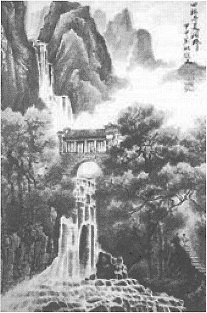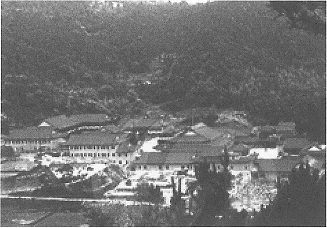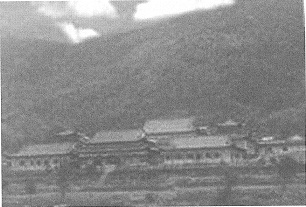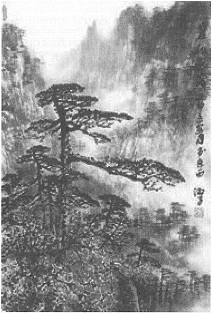|
 在「真如寺」時,有位師兄告訴我們:當去參訪「四祖寺」(黃梅道信禪師)的住持淨慧老法師;他是當今大陸佛教界的活字典,他住持此寺的條件,是不收門票、撤走旅遊局的人,使佛教回歸於正統。「四祖寺」修蓋得非常氣派,是由九十九歲的本煥老和尚號召善心人士所捐獻的,充滿文化氣息。寺內有瀑布,在「靈潤橋」下,遊客可觀賞瀑布水流下的石頭,上有古代詩人雅客的手跡(此「碧玉流」因柳宗元的詩作而享盛名);「毗盧塔」則高高矗立於山頂上,那是當年四祖肉身之所在。 在「真如寺」時,有位師兄告訴我們:當去參訪「四祖寺」(黃梅道信禪師)的住持淨慧老法師;他是當今大陸佛教界的活字典,他住持此寺的條件,是不收門票、撤走旅遊局的人,使佛教回歸於正統。「四祖寺」修蓋得非常氣派,是由九十九歲的本煥老和尚號召善心人士所捐獻的,充滿文化氣息。寺內有瀑布,在「靈潤橋」下,遊客可觀賞瀑布水流下的石頭,上有古代詩人雅客的手跡(此「碧玉流」因柳宗元的詩作而享盛名);「毗盧塔」則高高矗立於山頂上,那是當年四祖肉身之所在。
當知客師領我們到寮房時,遇到一位年輕比丘和我們打招呼;知道我們來自「萬佛城」,親切的要我們告訴他「萬佛城」的情況。他告訴我們,他是哈爾濱人,非常崇拜宣公上人,以前便曾看他老人家的書。他熱心地告訴我們:再過兩天,這兒就要打三個禪七,邀請我們留下參加,說住持淨慧老法師也會來帶領大家。
四祖正覺禪寺 Fourth Patriarch Monastery |
 |
禪七的前一天,淨慧老法師到了,大家都去拜見他。老法師很熱情的招待我們,並告訴我們他在87、89年和上人交談的往事,他也很關心「萬佛城」及法師們。室友告訴我,他曾是虛老的侍者,虛老送他入佛學院學習;他在文革時為保護六祖的真身,隨時搬移,以防紅衛兵的破壞。2003年,本煥老和尚請他住持「四祖寺」。
在起七的前一天,由各地來的有八十多位居士,除了來自美國的我們,還有自山東、河北、湖南、江西、四川、雲南、江蘇、福建、廣東等省;更有從網路上得知打七消息的韓國人,及參加大專夏令營得過禪味的青年學生;加上「四祖寺」老少信眾,年齡由二十到七十歲不等。當家師先對大眾開示「如何包腿保暖」等打坐的要點,非常有耐性的教導和演練,安排每一個人的坐位及講解規矩;他聲音洪亮,嚴格地訓練大家經行及坐禪。
老和尚指出用功的六字口訣:專注,清明,綿密。他提倡禪文化和生活禪,提升精神的淨化,使佛法與現實生活不脫節。他在開示時,要求出家人學習真如寺的修行道風;也向大眾提及萬佛城修行之嚴謹,及其出家人之素質。
有一位來自武漢的中年男子,他的腿曾斷了,行動不便,他還不缺一堂的坐完三個七。一位來自四川的七十歲老婦人,雖然因打磕睡被重重的打香板,也毫不退心,不缺一堂。山東的小女孩,她參加此地的夏令營後嘗到法味,便報名了這次的打七,腿疼難忍,也忍下來了。三七打完後,她笑口常開,並說她的心得是只想大笑,好輕鬆、好開心。禪七在當家師所說的「緣聚緣散,源源不斷」,及「一人挨一個香板」中結束了。
此次禪七,我以這首偈頌,留作紀念:
四祖寺裏打禪七,好吃好喝好精神。
三七堂中苦鑽研,無間地獄受熬煎。
生死流浪無盡時,煩惱狂心幾時歇。
妄想執著從何來,無明貪愛從何起。
誰是本來真面目,輪迴六道又是誰。
靜心觀察平等性,空中非空有非有。
黑暗光明本一體,煩惱菩提亦非二。
守心規矩檢點行,老實念佛回家去。

這次的走訪,很歡喜地看見了佛法在中國振興起來;無論出家人、在家人,大多曾研讀過上人的開示或淺釋,上人的《大佛頂首楞嚴經淺釋》更是大家的法寶。中國佛教界都受到上人的影響,對上人十分崇拜讚歎;佛法在文革時,遭遇浩劫,幸有上人在美國繼續講經說法。法寶在中國改革開放後,隨之流入;尤其難得的是在87、89年,上人邀請大陸上百位僧人到萬佛城來參訪,使正法在困難的環境中復甦。
現在的新一代,他們很有善根,有的能出家修行弘揚佛法,有的在家護持三寶,我相信都是深獲上人的法乳所致。上人雖在西方傳法,而東方人亦受益;正如《華嚴經》〈賢首品〉所說,「或於東方入正定,而於西方從定出;或於西方入正定,而於東方從定出」,不受時間、空間的約束。在真如寺一位來自九華山的老法師問我,上人臨終時留下什麼遺言?我說:「『我從虛空來,回到虛空去。』上人並要弟子誦《華嚴經》。」這次大陸遊的經歷,令我感念上人,他的教誨非但影響我、我的家庭、我的朋友,更改變了我的世界,及其他人的世界。上人為要我們開悟,慈悲教誨,希望我們去執著、離分別,同住無生彼岸。他所做的一切,都是為眾生,又是無念、無欲、無私、無我、無牽、無掛的為眾生,正如他老人家常說 Everything is O.K.,他所展現的,就是華嚴境界,與無止盡、無時空限制的大慈大悲。
|
|
 A Dharma brother in Zhenru Monastery told us we should visit the abbot of the Fourth Patriarch Monastery (Huangmei Dhyana Master Dao Xin) who is known to be a “living dictionary” of Buddhism in Mainland China. When he was invited to become the abbot of the monastery, he stipulated his conditions for accepting the job: there must be no entrance fee and the Tourism Department must not interfere in the operation of the temple business so Dharma can return to its tradition of authenticity. The temple is very grand and very culturally rich. It was built with funds raised by the 99-year-old Dharma Master Ben Huan. There is a waterfall inside the temple and people can read the original handwriting of ancient poets under the Soul Nourishment Bridge. The Vairochana Pagoda sits high on the top of the mountain. The Fourth Patriarch’s body used to be housed there. A Dharma brother in Zhenru Monastery told us we should visit the abbot of the Fourth Patriarch Monastery (Huangmei Dhyana Master Dao Xin) who is known to be a “living dictionary” of Buddhism in Mainland China. When he was invited to become the abbot of the monastery, he stipulated his conditions for accepting the job: there must be no entrance fee and the Tourism Department must not interfere in the operation of the temple business so Dharma can return to its tradition of authenticity. The temple is very grand and very culturally rich. It was built with funds raised by the 99-year-old Dharma Master Ben Huan. There is a waterfall inside the temple and people can read the original handwriting of ancient poets under the Soul Nourishment Bridge. The Vairochana Pagoda sits high on the top of the mountain. The Fourth Patriarch’s body used to be housed there.
While the Guest Prefect Master was guiding us to our room, a young Bhikshu gave us a greeting. Hearing that we came from the City of Ten Thousand Buddhas (CTTB), he asked us to tell him more about CTTB. He told us that he was from Harbin and has always admired the Venerable Master Hua. He had also read some of the Master’s books in the past. He invited us to join the three-week Chan session that was going to be held in two days and led by the abbot, Dharma Master Jing Hui (Purity and Wisdom).
The day before the Chan session, Elder Dharma Master Jing Hui arrived. We all went to pay respect to him. He received us very warmly and shared with us his conversation with Master Hua in 1987 and 1989. He also showed genuine interest in the current situation of the City of Ten Thousand Buddhas and the Dharma Masters there. My roommate told me that he used to be the attendant of Ven. Master Xu Yun. Later Ven. Master Xu Yun sent him to a Buddhist Academy for further Buddhist education. During the Cultural Revolution, he had to protect the actual flesh-body of the Sixth Patriarch by moving it so the Red Guards would not be able to locate and destroy it. In 2003, Master Jing Hui was invited by Master Ben Huan to be the abbot of the Fourth Patriarch Monastery.
Over 80 lay people arrived the day before the Chan session. Besides two of us who came from the United States, other participants came from various provinces such as Shandong, Hebei, Hunan, Jiangxi, Sichuan, Yunnan, Fujian and Guangdong. Additionally, there was a Korean lay participant who found out about the session through the Internet and young students who got a taste of Chan during a previous summer camp. The rest were disciples from the Fourth Patriarch Monastery. Their ages ranged from the 20’s to 70’s.
The temple manager started the Chan session with a lecture on how to wrap our legs to keep them warm and then covered key points of meditation practice. He taught us with great patience and eloquence, combined with demonstrations of how to practice. He made the seating arrangements for everyone and instructed us on the rules of the Chan Session, followed by strict training on walking and sitting meditation. His voice was clear and energetic.
The Venerable Abbot pointed out a six-word mnemonic device on how to practice: focus, concentration, clarity, purity, persistence and continuation. He advocates integrating Chan in our cultures and lives so that our spirits are uplifted and purified, and the Buddhadharma fuses with the practical aspects of our everyday life. When he gave the instructional talk, he required the monastics at the temple to learn the vigorous tradition of Zhenru Monastery. He has also mentioned the strict cultivation of the monastics at CTTB, which is known for training monastics of high caliber.
A middle-aged man from Wuhan city had crippled legs which made it very difficult for him to move around, yet he never missed a sit and completed the three-week Chan session. A 70-year-old woman from Sichuan province was hit by the proctor’s board many times when she dozed off in the Chan Hall. However, she never retreated or missed a sitting period. A little girl from Shandong signed up for this Chan session because of her past experience in a local “Dharma Flavors Summer Camp”. Even though the leg pain from sitting in Chan was hard to endure, she endured it. After the Chan session, she smiled constantly and reported that she just wanted to laugh. After the session, she felt happy and lighthearted. The manager of the monastery said, “Conditions bring us together and cause us to disperse; this goes on continuously.” The session concluded with everyone being hit by the incense board.
The following is a verse to remember this Chan session:
Participating in the Chan session in the Fourth
Patriarch Monastery,
With good food and drink, I maintained good energy.
Working hard to investigate in the hall for twenty-one days,
People were tormented as if in the perpetual hells.
There is no end to the drifting in the cycle of birth and death.
When will the afflicted crazy mind rest?
Where did the distorted thoughts and attachment come from?
When did ignorance, greed and love arise?
What is my original face?
Who is transmigrating in the six paths?
Quietly observe the nature of equality: there is no emptiness, existence or non-existence in empty space.
Darkness and brilliance are of one substance.
Afflictions and Bodhi are not two, either.
Guard the mind and discipline the behavior.
Honestly recite the Buddha’s name to return home.
From this trip, I am very delighted to see that the Buddhadharma has rejuvenated in China. Whether it be monastics or laity, most have read or studied Venerable Master Hua’s instructional talks or commentaries on sutras.
The Venerable Master Hua’s Commentary on the Shurangama Sutra is even more of a treasure to them. The Venerable Master has definitely influenced Buddhism in China and was extolled by the general public, especially in Buddhist circles. The Buddhadharma had suffered a catastrophe and was brutally crushed during the Cultural Revolution. Luckily, the Venerable Master continued to speak Dharma in the United States during that time. Since restrictions or bans were lifted after the Cultural Revolution, “Dharma jewels” had subsequently flown from America back to China. What was even harder to come by was that the Venerable Master invited more than a hundred monastics from China to visit the City of Ten Thousand Buddhas in 1987 and 1989. This has helped revive the Proper Dharma in difficult circumstances.
The newest generation of Chinese that I saw have very good roots—some are able to leave home and venture forth as monastics to enhance and propagate the Buddhadharma; some as laity support the Triple Jewel with their resources. I personally believe that many of them must have benefited from the Venerable Master Hua’s Dharma. Although the Venerable Master propagated Dharma in the West, people in the East also benefited. As the Worthy Leader Chapter of the
Avatamsaka [Flower Adornment] Sutra describes, one can “enter samadhi in the east and come out in the west; enter samadhi in the west and come out in the east…” The Venerable Master was not bound in the least by time and space. At Zhenru Monastery, an elder Dharma Master from Jiuhua (Nine Flower) Mountain asked me what Venerable Master’s last words were before he passed away. I replied: “‘I came from the empty space. I also return to the empty space.’ The Venerable Master also asked his disciples to recite the
Avatamsaka Sutra after his passing.” On my trip I was always thinking of the Venerable Master Hua. His instructions not only influenced me but also my family, friends, my world and others’ worlds. To help us awaken to the Truth, he compassionately taught us to get rid of our attachment, renounce all discriminations, and dwell on the shore of the nonarising of phenomena. He did everything for the sake of living beings. Everything he did was free of thought, desire, selfishness, self, worry, and attachment. As he always said, “Everything is O.K.” He demonstrated the Avatamsaka state of infinite great kindness and great compassion unrestricted by time and space.
|